Jadual Kandungan
Malaria di Tanah Melayu (1880-1910)
Dirujuk oleh
Kronologi
1880-1900: Penularan Wabak Malaria
Sebagaimana wabak lain, malaria mula menular di Tanah Melayu pada akhir kurun ke-20. Walaupun punca spesifik setiap wabak hanya diketahui berpuluh tahun selepas penularannya, puncanya secara umum ialah penyahhutanan besar-besaran untuk tujuan pembukaan kawasan ladang dan perlombongan yang besar, serta jaringan jalan-jalan pengangkutannya, yang mengakibatkan ketidakseimbangan ekologi dan penularan wabak. Pekerja migran yang dibawa masuk oleh pihak British pula tidak mempunyai daya ketahanan semulajadi terhadap wabak tempatan. Pakar serta kakitangan perubatan British pula, kurang berpengalaman dan berpengetahuan mengenai wabak-wabak tersebut, lalu mengakibatkan puluhan ribu pekerja terkorban olehnya: “…jangkamasa 1896-1914 merupakan tempoh yang paling penting untuk memahami peranan British dalam mengawal penularan penyakit ekoran eksploitasi ekonomi yang dialami oleh negeri Melayu di bawah pentadbiran British. Menurut J. Norman Parmer, “British rule first made the incidence of disease and death very much worse than before. The clearing of land for estates, the expansion of mining and the construction of public works disturbed existing ecological balances, causing diseases to spread and multiply. The large immigrant labour forces assembled for these capital investments lacked natural immune systems. The colonial government, the chief provider of medical services, also lacked experience and knowledge and as a consequence many tens of thousands of workers died.”” (Noraini Mohamed Hassan, 2004: |"Penyakit tropika di Negeri-Negeri Melayu Bersekutu, 1896-1914 : tumpuan kepada penyakit beri-beri, malaria dan penyakit usus", BAB SATU: PENGENALAN).
1901-1908: Kawalan Wabak di Klang, oleh Dr. Malcolm Watson
Wabak malaria telah pun melanda beberapa daerah yang telah diterokai secara besar-besaran sejak akhir kurun ke-19, contohnya yang direkodkan di Klang pada tahun 1901. District Surgeon Klang ketika itu, (Sir) Dr. Malcom Watson (1873-1955), berjaya mengawal wabak ini dengan mengeringkan kawasan paya di situ. Pada tahun 1907, beliau bersara dan meneruskan kajiannya, dan menjadi penasihat kesihatan di ladang-ladang seluruh Selangor: “It all began at the turn of the 20th century, when the Selangor state surgeon Dr Malcolm Watson started work on malaria control following a serious epidemic that floored many Klang residents. With full government aid and a $30,000 Sanitary Board grant to drain waterlogged swamps, Watson initiated mitigating measures that were met with resounding success both in Klang and Port Swettenham. By 1907, Dr Watson resigned from government service and began devoting more time and study towards malaria. He collected invaluable data and gained new insights into the disease by serving as medical adviser to many rubber estates that were rapidly opening up all over Selangor.” (Alan Teh Leam Seng @ New Straits Times, June 16 2021: |"Malaya led the way in medical research").
Berikut adalah beberapa petikan buku Dr. Malcolm Watson, 1911: |"The prevention of malaria in the Federated Malay States" yang mendokumenkan beberapa langkah kawalan malaria. Untuk tujuan ringkasan, petikan yang diambil adalah khusus untuk kawasan Klang sahaja:-
1901-01: Memulakan tugas sebagai District Surgeon di Klang
Hospital Klang dipenuhi dengan pesakit malaria: “Assuming duty early in January, 1901, as Government Surgeon of the Districts of Klang, Kuala Selangor and Kuala Langat of the State of Selangor, one of the Federated Malay States, I found the hospital at Klang full of malaria.” (m.s.14).
Port Swettenham (dibina 1 Januari 1900, kini Pelabuhan Klang) baru siap dibina di bekas paya bakau. Tiada sistem perparitan dan kebanyakan paya masih kekal, lalu menjadi sarang nyamuk. Akibatnya ramai pekerja dan penduduk yang baru dijangkiti malaria: “…the wharfs were practically completed, and only the finishing touches were being given to the station buildings. There were few inhabitants in the place, and there were few cases of malaria. But I observed that new arrivals quickly became affected. I also heard there had been a considerable amount of malaria among the workmen formerly employed there. The place was practically a mangrove swamp, in which about 15 acres had been cleared. No attempt had been made to reclaim or drain it, and it was full of Anopheline breeding places.” (m.s.25).
Satu-satunya usaha yang dianggap realistik ketika itu adalah membina sistem perparitan atau mengambus kawasan paya dan kolam yang berdekatan, untuk mengurangkan kawasan pembiakan nyamuk: “At Klang the work of eradicating malaria seemed well nigh hopeless. No hot or cold season even temporarily stopped the mosquito pest, and every well, ditch and swamp teemed with larvae. The active co-operation of the native community could not be expected, and active resistance, especially from the Chinese, was certain if any attempt were made to enforce the use of quinine. An enforcement of mosquito nets was, of course, impossible since this would have meant constant house visitation at night. Compulsory screening of the whole of all the houses was impossible for financial reasons. The large acreage of swamp, the heavy rainfall and the amount of supervision required, apart altogether from its cost and temporary efficacy, prohibited the use of petroleum. … Considering all these elements of the problem, I rejected as impossible Koch's quinine method, and the Italian mechanical prophylaxis, and decided to recommend Ross's method of mosquito reduction. To suit the local conditions I determined that any expenditure should be on works of a permanent nature. By draining and filling there would be a large and permanent reduction of the breeding places of mosquitos, and presumably malaria would be correspondingly reduced.” (m.s.14).
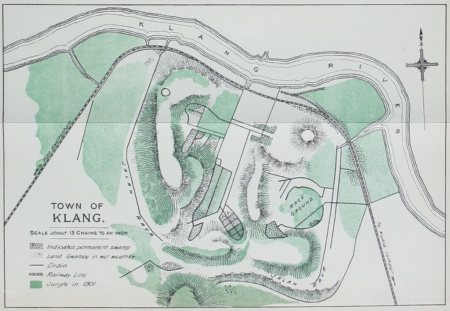

Kiri: Peta Pekan Klang, tahun 1901. Peta menunjukkan kawasan paya di tengah-tengah bandar Klang yang menjadi pusat pembiakan nyamuk: “The area of the town was in 1901 approximately 290 acres. Of this 22 acres was swamp, 25 acres virgin jungle, and 80 acres dense secondary growth in many places 30 to 40 feet high. The distribution of these undesirable portions will be seen from the map. The whole town was permeated with their influence, and it is hardly surprising that malaria was a scourge. … As will be seen from the map the town is situated within, upon and around a somewhat semi-circular group of small hills. At the foot of the hills, especially where they bend to form small valleys, the ground water was so high as to form permanent swamp. In the absence of a town water supply, wells innumerable were found mostly teeming with Anopheline larvae.” (m.s.12-14, 17).
Kanan: Peta Port Swettenham, tahun 1901.
1901-05: Cadangan Pengambusan dan Perparitan
Pada Mei 1901, Dr. Watson membentangkan cadangan pengambusan paya dan perparitan kepada Lembaga Kebersihan / Sanitary Board Klang, dan diluluskan atas sokongan pengarahnya, Mr. H.B. Ellerton. Ianya dibentangkan kepada State Surgeon Selangor Dr. E.A.O.Travers pada Julai 1901, dan menerima sokongan penuh beliau serta pihak kerajaan. Pada bulan-bulan selepasnya, wabak Malaria meningkat mendadak di kalangan penduduk Klang. Penguatkuasaan undang-undang tahun 1890, yang mewajibkan setiap pemilik tanah mengambus atau mengalirkan paya dan air bertakung, telah dipertingkatkan. (m.s.20-23).
1901-09-15: Pembukaan Port Swettenham
Sementara itu, Port Swettenham dibuka. Wabak malaria terus menjangkiti kebanyakan pekerja, menyebabkan mereka berpindah semula ke Klang, dan pelabuhan terpaksa ditutup. Sebuah suruhanjaya ditubuhkan bagi menangani masalah ini, dan mereka mengarahkan perlaksanaan langkah-langkah pengambusan dan perparitan yang telah dicadangkan sebelum ini. Ianya berjaya meredakan keadaan, dan pelabuhan dapat beroperasi: “On 15th September, 1901, the port was opened, and the Government population and the coolies connected with the shipping were transferred to Port Swettenham. … Immediately after the port was opened malaria assumed an epidemic character. In less than a month the 180 loading coolies were so decimated by disease that the remnant refused to live any longer at the port, and returned to Klang. … The Harbour and Railway Departments were so crippled that they could only imperfectly do their duties, and so utterly demoralised di the Port become, that the High Commissioner ordered the closure of the Port until it could be made more sanitary. It was, however, useless to return to Klang, and Government advised the trial of the recommendations of a Commission, consiting ofo the Director of the Institute for Medical Research (H. Wright), the State Surgeon (E.A.O. Travers), the District Surgeon, Klang (M. Watson), the Genral Manager for Railways (C.E. Spooner), the State Engineer (B.P. McGlashan), and the Resident Engineer for Railways (A.J. Watkins, and later, D.J. Highet), which in the meantime had been appointed. The Commission advised the measures which I had recommended the previous April, and within six weeks the work of the Port was proceeding without great difficulty. An area of about 100 acres were bunded, drained, and freed from jungle. Quinine was systematically given to all who would take it, and most did. The outbreak had so much diminished by the time information about wire gauze was received, that none was ever required.” (m.s. 26-28).
1903-1905: Wabak Dalam Kawalan
Pada Disember 1903 dan Januari 1904 (1-2 tahun setelah projek pengambusan paya), Dr. G.F.Leicester masih merekodkan kehadiran nyamuk spesis Anopheline (tiruk, pembawa malaria) di pelbagai tempat takungan air (semulajadi atau pun tidak) di Klang. Hal ini berlarutan sehingga Mr. E.V. Carey mencadangkan perparitan di lereng bukit, sebagaimana yang diamalkan di ladang-ladang: “In December, 1903, and January, 1904, Dr. G.F. Leicester investigated the Anophelines of Klang and reported as follows in his 'Culicidae of Malaya'… The work was not, however, finished all at once and even in 1904 some small swamps were still in existence. It was not until Mr. E.V. Carey pointed out that the only way of draining the swamps effectively was by contour drains at the foot of the hills, the method universally employed by planters, that these were really dry.” (m.s.17, 23).

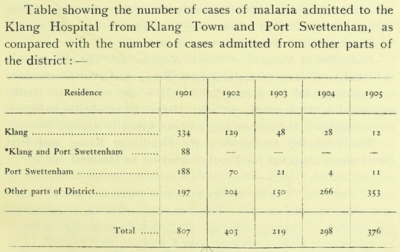
Hasilnya, menurut statistik kemasukan pesakit malaria di Hospital Klang, keadaan wabak malaria telah terkawal menjelang tahun 1905, hasil langkah-langkah pembasmian pembiakan nyamuk yang telah dijalankan sebelum ini. (m.s. 29).
1905-1910: Penaiktarafan Sistem Perparitan
Setelah beberapa projek pengambusan dan perparitan dijalankan, beberapa dapatan dan kelemahan telah dikenalpasti dan diperbaiki, antaranya:-
- Sistem perparitan jauh lebih berkesan berbanding pengambusan paya.
- Terdapat beberapa sistem perparitan yang tidak cekap dan gagal mengambil kira pasang surut air sungai dan laut, menyebabkan airnya tidak mengalir dengan baik di beberapa tempat, lalu menjadi tempat pembiakan nyamuk.
- Prosedur pembinaan dan penyelenggaraan jalan raya serta jalan keretapi yang tidak dilengkapi langkah perparitan yang sewajarnya, menyebabkan takungan air berlaku di sepanjangnya, lalu menjadi tempat pembiakan nyamuk.

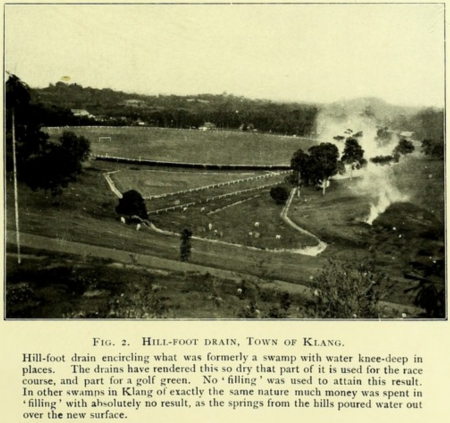
Keadaan kawasan “Race Ground” pekan Klang (sekitar Stadium Sultan Sulaiman kini) setelah perparitan dibina, sekitar 1910: (m.s.24-25).
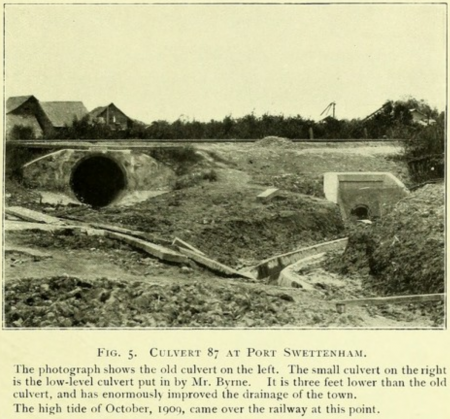
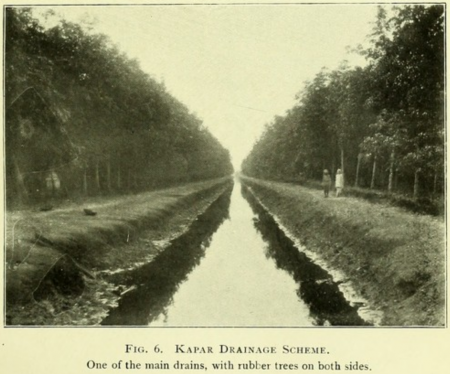
Kiri: Perparitan air pasang di Port Swettenham, sekitar 1910
Kanan: Perparitan di kawasan ladang di Kapar, sekitar 1910
(m.s. 38-39).
(Sumber: Dr. Malcolm Watson, 1911: |"The prevention of malaria in the Federated Malay States").
| Laman Utama | Hubungi Kami | ||||||||
| Siri Cebisan Sejarah: | Bangi | Gambang | Hutan | Ipoh | Kajang | Kuala Lumpur | Kuantan | Pulau Pinang | Hubungi Kami |
